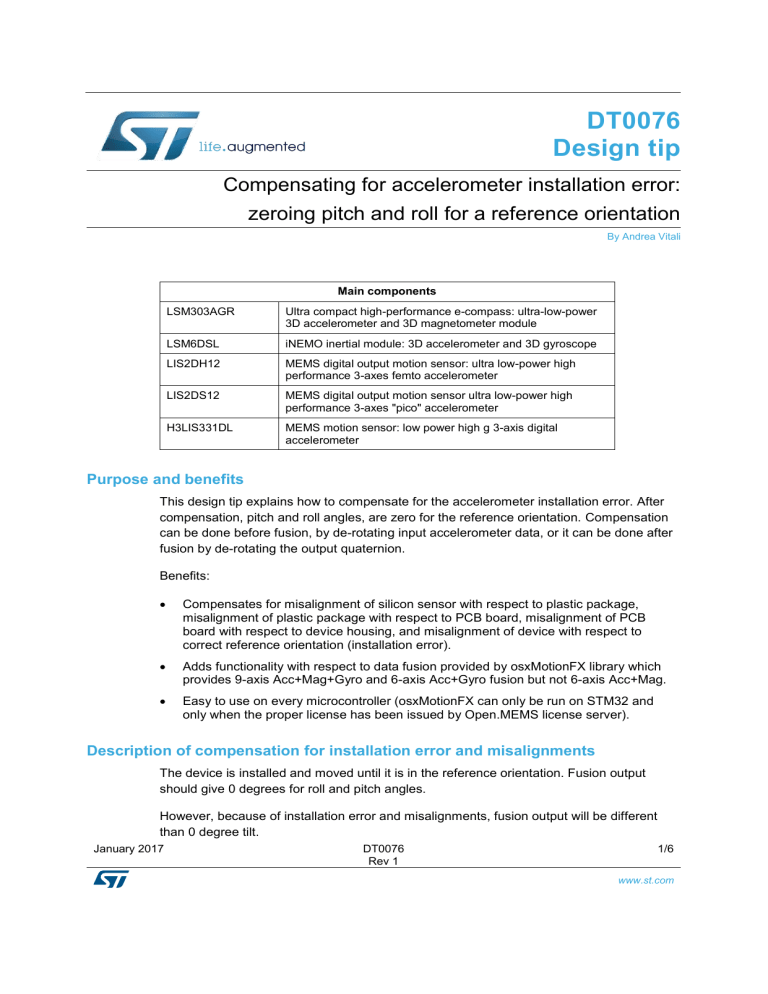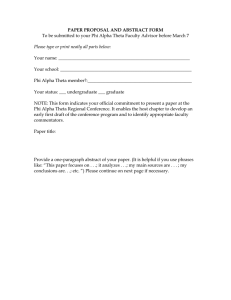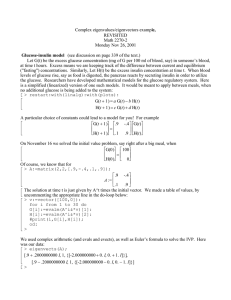
DT0076 Design tip Compensating for accelerometer installation error: zeroing pitch and roll for a reference orientation By Andrea Vitali Main components LSM303AGR Ultra compact high-performance e-compass: ultra-low-power 3D accelerometer and 3D magnetometer module LSM6DSL iNEMO inertial module: 3D accelerometer and 3D gyroscope LIS2DH12 MEMS digital output motion sensor: ultra low-power high performance 3-axes femto accelerometer LIS2DS12 MEMS digital output motion sensor ultra low-power high performance 3-axes "pico" accelerometer H3LIS331DL MEMS motion sensor: low power high g 3-axis digital accelerometer Purpose and benefits This design tip explains how to compensate for the accelerometer installation error. After compensation, pitch and roll angles, are zero for the reference orientation. Compensation can be done before fusion, by de-rotating input accelerometer data, or it can be done after fusion by de-rotating the output quaternion. Benefits: Compensates for misalignment of silicon sensor with respect to plastic package, misalignment of plastic package with respect to PCB board, misalignment of PCB board with respect to device housing, and misalignment of device with respect to correct reference orientation (installation error). Adds functionality with respect to data fusion provided by osxMotionFX library which provides 9-axis Acc+Mag+Gyro and 6-axis Acc+Gyro fusion but not 6-axis Acc+Mag. Easy to use on every microcontroller (osxMotionFX can only be run on STM32 and only when the proper license has been issued by Open.MEMS license server). Description of compensation for installation error and misalignments The device is installed and moved until it is in the reference orientation. Fusion output should give 0 degrees for roll and pitch angles. However, because of installation error and misalignments, fusion output will be different than 0 degree tilt. January 2017 DT0076 Rev 1 1/6 www.st.com There are three options to compensate for the installation error and misalignment: 1. Subtraction of reference Pitch and Roll, measured in reference orientation. This gives acceptable results only if installation error is small and only if angles to be corrected are small. 2. De-rotation of input data vector, so that the output of the fusion will give 0 in the reference orientation. This gives perfect compensation in all cases. 3. De-rotation of output quaternion, so that the output of fusion is corrected to give 0 in the reference orientation. This gives perfect compensation in all cases. Compensation by subtraction of reference Pitch and Roll (not always effective) Step 1, calibration: the device is installed and activated. The output of the fusion in this reference position, reference Roll (Phi) and reference Pitch (Theta), is stored in memory and used later to perform the compensation. Step 2, compensation: the device is active and operating as usual. The output of the fusion is corrected by subtracting the reference Roll and reference Pitch recorded in the previous step. This will give acceptable accuracy only if the corrections to be applied is small and only if angles to be corrected are small. If the output is a quaternion, it can be converted to Euler angles using the following function: function [phi,theta,psi]=quat2euler(Q) % North-East-Down reference frame (see Figure) % Roll(phi) Pitch(theta) Yaw(psi), angles in radians qw=Q(1); qx=Q(2); qy=Q(3); qz=Q(4); qw2=qw*qw; qx2=qx*qx; qy2=qy*qy; qz2=qz*qz; m=qw2+qx2+qy2+qz2; th=0.5*m-0.01; t=qw*qy-qz*qx; % 0.01 tolerance if(m<=0.0), psi=0.0; theta=0.0; phi=0.0; return; if(t>=+th), psi=-2.0*atan2(qx,qw); theta=+pi/2; phi=0.0; return; if(t<=-th), psi=+2.0*atan2(qx,qw); theta=-pi/2; phi=0.0; return; psi=atan2(2.0*(qw*qz+qx*qy),qw2+qx2-qy2-qz2); t=2.0*t/m; if(abs(t)>1.0), theta=0.0; else theta=asin(t); end; phi=atan2(2.0*(qw*qx+qy*qz),qw2-qx2-qy2+qz2); end for singularity end; % error end; % North end; % South North and South singularities: if Theta = +/-90 deg, Phi and Psi will describe a rotation around the same vertical axis (one degree of freedom is lost, this is also known as gimbal lock); when converting back and forth, the sum Psi+Phi will be correct when Theta=-90 deg, and the difference Psi-Phi will be correct when Theta=+90 deg. Compensation by de-rotation of input data vector (always effective) Step 1, calibration: the device is installed and activated. The output of the fusion in this reference position, Euler angles or quaternion, is converted to a de-rotation matrix, which is stored in memory and used later to perform the compensation. The de-rotation matrix is the inverse or transpose of the rotation matrix. This is the code and the functions to compute the de-rotation matrix from the Euler angles: January 2017 DT0076 Rev 1 2/6 www.st.com M = derotM(euler2rotM(phi,theta,psi); % de-rotation matrix function MD = derotM(M) % inverse is the same as transpose, inv(M) == M’ MD = [M(1,1),M(2,1),M(3,1); M(1,2),M(2,2),M(3,2); M(1,3),M(2,3),M(3,3)]; end function M = euler2rotM(phi,theta,psi) % North-East-Down reference frame (see Figure) % Roll(phi) Pitch(theta) Yaw(psi), angles in radians m11= cos(theta)*cos(psi); m12= cos(theta)*sin(psi); m13=-sin(theta); m21=sin(phi)*sin(theta)*cos(psi)-cos(phi)*sin(psi); m22=sin(phi)*sin(theta)*sin(psi)+cos(phi)*cos(psi); m23=sin(phi)*cos(theta); m31=cos(phi)*sin(theta)*cos(psi)+sin(phi)*sin(psi); m32=cos(phi)*sin(theta)*sin(psi)-sin(phi)*cos(psi); m33=cos(phi)*cos(theta); M = [m11,m12,m13; m21,m22,m23; m31,m32,m33]; end The de-rotation matrix is computed from the conjugate quaternion. This is the code and the functions to compute the de-rotation matrix from the quaternion: M = derotM(quat2rotM(Q)); % inverse/transpose rotation from quaternion M = quat2rotM(quat2conj(Q)); % same as: rotation matrix from conjugate quaternion function [QC] = quat2conj(Q) QC = [Q(1),–Q(2),–Q(3),–Q(4)]; end function M = quat2rotM(Q) qw=Q(1); qx=Q(2); qy=Q(3); qz=Q(4); qw2=qw*qw; qx2=qx*qx; qy2=qy*qy; qz2=qz*qz; n=1./(qw2+qx2+qy2+qz2); m11=( qx2 -qy2 -qz2 +qw2)*n; m22=(-qx2 +qy2 -qz2 +qw2)*n; m33=(-qx2 -qy2 +qz2 +qw2)*n; t1=qx*qy; t2=qz*qw; m12=2*(t1+t2)*n; m21=2*(t1-t2)*n; t1=qx*qz; t2=qy*qw; m13=2*(t1-t2)*n; m31=2*(t1+t2)*n; t1=qy*qz; t2=qx*qw; m23=2*(t1+t2)*n; m32=2*(t1-t2)*n; M=[m11 m12 m13; m21 m22 m23;m31 m32 m33]; end Step 2, compensation: the device is active and operating as usual. The input data vector for the fusion is corrected by multiplication by the de-rotation matrix. De-rotation should be done for both the accelerometer data vector and the magnetometer data vector. After derotation, the data can be fed into the fusion algorithm. function [xr,yr,zr] = rotMbyvect(M,x,y,z) xr = M(1,1)*x + M(1,2)*y + M(1,3)*z; yr = M(2,1)*x + M(2,2)*y + M(2,3)*z; zr = M(3,1)*x + M(3,2)*y + M(3,3)*z; end Compensation by de-rotation of output quaternion (always effective) Step 1, calibration: the device is installed and activated. The output of the fusion in this reference position, Euler angles or quaternion, is converted to a de-rotation quaternion, which is stored in memory and used later to perform the compensation. January 2017 DT0076 Rev 1 3/6 www.st.com The de-rotation quaternion is the conjugate quaternion. If the output is Euler angles, it can be converted to de-rotation quaternion using the following function: Q = quat2conj(euler2quat(phi,theta,psi)); function Q = euler2quat(phi,theta,psi) % North-East-Down reference frame (see Figure) % Roll(phi) Pitch(theta) Yaw(psi), angles in radians cosr2=cos(phi/2); sinr2=sin(phi/2); cosp2=cos(theta/2); sinp2=sin(theta/2); cosy2=cos(psi/2); siny2=sin(psi/2); qw = cosr2*cosp2*cosy2 + sinr2*sinp2*siny2; qx = sinr2*cosp2*cosy2 - cosr2*sinp2*siny2; qy = cosr2*sinp2*cosy2 + sinr2*cosp2*siny2; qz = cosr2*cosp2*siny2 - sinr2*sinp2*cosy2; Q=[qw qx qy qz]; end Step 2, compensation: the device is active and operating as usual. The output of the fusion P is corrected by multiplication with the de-rotation quaternion Q. If the output of the fusion is Euler angles, it can be converted to a quaternion using the function listed in the first paragraph. function R = quatbyquat(P,Q) pw=P(1); px=P(2); py=P(3); qw=Q(1); qx=Q(2); qy=Q(3); rw = pw*qw - px*qx - py*qy rx = pw*qx + px*qw + py*qz ry = pw*qy - px*qz + py*qw rz = pw*qz + px*qy - py*qx R = [rw rx ry rz]; end pz=P(4); qz=Q(4); - pz*qz; - pz*qy; + pz*qx; + pz*qw; Simplified reference code For convenience, a more compact function is presented here to compensate for the installation error and misalignments. This is the function to de-rotate the input data vector, when Euler angles (Phi for Roll, Theta for Pitch, Psi for Yaw) are known for the reference orientation: function [xr,yr,zr] = derotate_vector(phi,theta,psi,x,y,z) % North-East-Down reference frame (see Figure) % Roll(phi) Pitch(theta) Yaw(psi), angles in radians % derotation matrix coefficients (rotation matrix is transposed) m11= cos(theta)*cos(psi); m21= cos(theta)*sin(psi); m31=-sin(theta); m12=sin(phi)*sin(theta)*cos(psi)-cos(phi)*sin(psi); m22=sin(phi)*sin(theta)*sin(psi)+cos(phi)*cos(psi); m32=sin(phi)*cos(theta); m13=cos(phi)*sin(theta)*cos(psi)+sin(phi)*sin(psi); m23=cos(phi)*sin(theta)*sin(psi)-sin(phi)*cos(psi); m33=cos(phi)*cos(theta); % derotate vector (product matrix by vector) xr = m11*x + m12*y + m13*z; yr = m21*x + m22*y + m23*z; zr = m31*x + m32*y + m33*z; end January 2017 DT0076 Rev 1 4/6 www.st.com This is the function to de-rotate the output quaternion, when Euler angles (Phi for Roll, Theta for Pitch, Psi for Yaw) are known for the reference orientation: function [rw,rx,ry,rz] = derotate_quat(phi,theta,psi,pw,px,py,pz) % North-East-Down reference frame (see Figure) % Roll(phi) Pitch(theta) Yaw(psi), angles in radians % derotation quaternion (rotation quaternion is conjugate) cosr2=cos(phi/2); sinr2=sin(phi/2); cosp2=cos(theta/2); sinp2=sin(theta/2); cosy2=cos(psi/2); siny2=sin(psi/2); qw = cosr2.*cosp2.*cosy2 + sinr2.*sinp2.*siny2; qx = -sinr2.*cosp2.*cosy2 + cosr2.*sinp2.*siny2; qy = -cosr2.*sinp2.*cosy2 - sinr2.*cosp2.*siny2; qz = -cosr2.*cosp2.*siny2 + sinr2.*sinp2.*cosy2; % derotate quaternion (product quaternion by conjugate quaternion) rw = pw*qw - px*qx - py*qy - pz*qz; rx = pw*qx + px*qw + py*qz - pz*qy; ry = pw*qy - px*qz + py*qw + pz*qx; rz = pw*qz + px*qy - py*qx + pz*qw; end Figure 1. Reference orientation for input data from accelerometer and magnetometer, and reference orientation for output data: roll, pitch and yaw angles. Accelerometer output is positive for axis aligned with gravity and pointing down Roll = +90 Pitch = +90 Yaw = +90 Roll = +90 Pitch = +90 Roll, Pitch, Yaw Acc (Gravity vector) Mag (Earth mag field) degrees G = 1g = 1000mg B = 10..90uT = 100..900 mG 0, 0, 0 0, 0, +G +B Cos(i), 0, +B Sin(i) +90, 0, 0 0, +G, 0 +B Cos(i), +B Sin(i), 0 0, +90, 0 -G, 0, 0 -B Sin(i), 0, +B Cos(i) 0, 0, +90 0, 0, +G 0, -B Cos(i), +B Sin(i) +90, +90, 0 -G, 0, 0 -B Sin(i), +B Cos(i), 0 Support material Related design support material BlueMicrosystem1, Bluetooth low energy and sensors software expansion for STM32Cube Open.MEMS, MotionFX, Real-time motion-sensor data fusion software expansion for STM32Cube Documentation January 2017 DT0076 Rev 1 5/6 www.st.com Related design support material Design Tip, DT0058, Computing tilt measurement and tilt-compensated e-compass Revision history Date 12-Jan-2017 Version 1 Changes Initial release IMPORTANT NOTICE – PLEASE READ CAREFULLY STMicroelectronics NV and its subsidiaries (“ST”) reserve the right to make changes, corrections, enhancements, modifications, and improvements to ST products and/or to this document at any time without notice. Purchasers should obtain the latest relevant information on ST products before placing orders. ST products are sold pursuant to ST’s terms and conditions of sale in place at the time of order acknowledgement. Purchasers are solely responsible for the choice, selection, and use of ST products and ST assumes no liability for application assistance or the design of Purchasers’ products. No license, express or implied, to any intellectual property right is granted by ST herein. Resale of ST products with provisions different from the information set forth herein shall void any warranty granted by ST for such product. ST and the ST logo are trademarks of ST. All other product or service names are the property of their respective owners. Information in this document supersedes and replaces information previously supplied in any prior versions of this document. © 2017 STMicroelectronics – All rights reserved January 2017 DT0076 Rev 1 6/6 www.st.com



